THE HEATSINK GUIDE: Information about heatsinks - part 1
General heatsink information
Heatsink Design
What characteristics make a heatsink a good one? There's a number of factors
to consider:
- High heatsink surface. It's at the surface of the heatsink where
the thermal transfer takes place. Therefore, heatsinks should be designed
to have a large surface; this goal can be reached by using a large amount
of fine fins, or by increasing the size of the heatsink itself.
- Good aerodynamics. Heatsinks must be designed in a way that
air can easily and quickly float through the cooler, and reach all cooling fins.
Especially heatsinks having a very large amount of fine fins, with small distances between
the fins may not allow good air flow. A compromise between high surface (many fins with
small gaps between them) and good aerodynamics must be found. This also depends on the
fan the heatsink is used with: A powerful fan can force air even through a heatsink
with lots of fine fins with only small gaps for air flow - whereas on a passive heatsink,
there should be fewer cooling fins with more space between them. Therefore, simply
adding a fan to a large heatsink designed for fanless usage doesn't necessarily
result in a good cooler.
- Good thermal transfer within the heatsink. Large cooling fins are pointless
if the heat can't reach them, so the heatsink must be designed to allow good thermal
transfer from the heat source to the fins. Thicker fins have better thermal conductivity; so
again, a compromise between high surface (many thin fins) and good thermal transfer (thicker
fins) must be found. Of course, the material used has a major influence on thermal
transfer within the heatsink. Sometimes, heat pipes are used
to lead the heat from the heat source to the parts of the fins that are further away
from the heat source.
- Perfect flatness of the contact area. The part of the heatsink that is
in contact with the heat source must be perfectly flat. A flat contact area allows you
to use a thinner layer of thermal compound, which will reduce the thermal resistance
between heatsink and heat source.
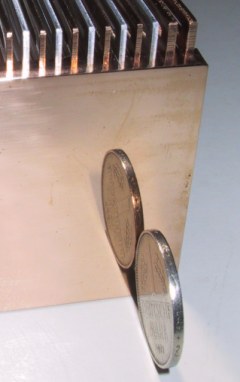
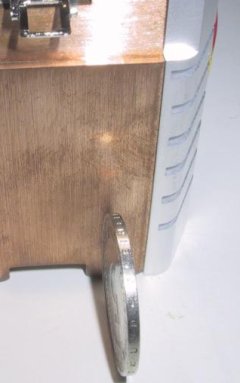
Good and bad example for contact area flatness
- Good mounting method. For good thermal transfer, the pressure between
heatsink and heat source must be high. Heatsink clips must be designed to provide
a strong pressure, while still being reasonably easy to install. Heatsink mountings
with screws/springs are often better than regular clips. Thermoconductive glue
or sticky tape should only be used in situations where mounting with clips or
screws isn't possible.
Measuring heatsink performance; thermal resistance θ
Heatsink performance is measured in °C/W (or K/W - since we're dealing
with temperature differences, there is no difference between Celsius and Kelvin scale here). We refer
to this as thermal resistance (θ).
An example for what these values mean: if a thermal load of 20W is applied to a heatsink,
and this causes the temperature of the heat source to raise by 10°C, the heatsink has
a rating of of 10°C/20W = 0.5°C/W.
A θ value is valid only for a certain power load and a certain temperature range.
The thermal resistance of standard coolers for PC CPUs is usually not specified by the heatsink
manufacturers, and if it is, it's often inaccurate or intentionally skewed for marketing purposes.
You cannot judge heatsink performance by comparing θ specifications from different
manufacturers.
The θ values specified by manufacturers specialized in heatsinks for industrial applications
(especially large passive heatsinks) are usually more accurate, though.
Heatsink testing is not an easy task; many of the heatsink reviews found on the countless
cooling-related sites on the net are not done properly. Check out my article
about common mistakes in heatsink reviews to help you read reviews critically and decide
which review to trust.
Heatsink materials
The thermal conductivity of the heatsink's material has a major impact on cooling performance.
Thermal conductivity is measured in W/mK; higher values mean better conductivity.
As a rule of thumb, materials with a high electrical conductivity also have a high thermal
conductivity. See this Wikipedia article
for more information on thermal conductivity.
Alloys have lower thermal conductivity than pure metals, but may have better mechanical or chemical (corrosion)
properties.
The following materials are commonly used for heatsinks:
- Aluminum. It has a thermal conductivity of 205W/mK, which is good (as a comparison:
steel has about 50W/mK). The production of aluminum heatsinks is inexpensive; they can be made using
extrusion Due to its softness, aluminum can also be milled quickly; die-casting and even cold
forging are also possible (see part 2 of this guide for more information about production methods).
Aluminum is also very light (thus, an aluminum heatsink will put less stress
on its mounting when the unit is moved around).
- Copper's thermal conductivity is about twice as high as aluminum - almost 400W/mK. This makes it
an excellent material for heatsinks; but its disadvantages include high weight, high price, and less
choice as far as production methods are concerned. Copper heatsinks can be milled, die-cast, or made
of copper plates bonded together; extrusion is not possible.
- To combine the advantages of aluminum and copper, heatsinks can be made of aluminum and copper
bonded together. Here, the area in contact with the heat source is made of copper, which helps lead the heat
away to the outer parts of the heatsink. The first heatsink for PC CPUs with an embedded copper piece was the Alpha P7125
(for first-generation Slot A Athlon CPUs). Keep in mind that a copper embedding is only useful
if it is tightly bonded to the aluminum part for good thermal transfer. This is not always the case,
especially not with inexpensive coolers. If the thermal transfer between the copper and the aluminum
is poor, the copper embedding may do more harm than good.
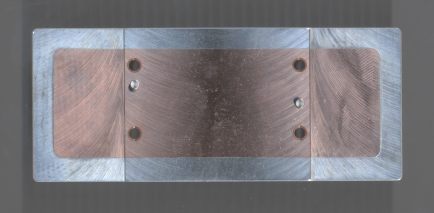
Alpha P7125 base plate
The copper plate helps spread heat across the base plate.
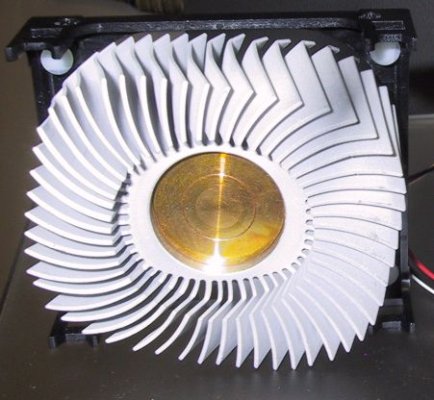
AVC heatsink with copper core
The copper core helps the heat move to the upper parts of the heatsink.
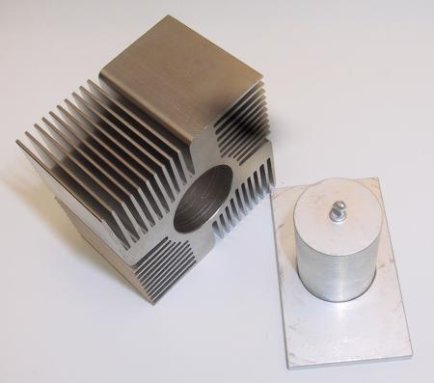
Thermalright heatsink (prototype) with large heat pipe in the center
A heat pipe provides substantially better thermal transfer than a solid piece of copper.
- Silver has an even higher thermal conductivity than copper, but only by about 10%.
This does not justify the much higher price for heatsink production - however, pulverized silver
is a common ingredient in high-end thermal compounds.
Go to part 2 of this article for info about heatsink production methods.
All pages copyright © 1997-2010 Tillmann Steinbrecher
Legal information / Disclaimer / Impressum






